Nicosia's architecture is a veritable encyclopaedia of history, from which you can learn more about the capital's rich past and its former rulers: the Venetians, the Ottomans, the British....
Many buildings bear the marks of more than one era, creating a kind of architectural cocktail in which seemingly opposing and contrasting styles complement each other. The Ottomans and the British have had the greatest influence on the city's appearance today.
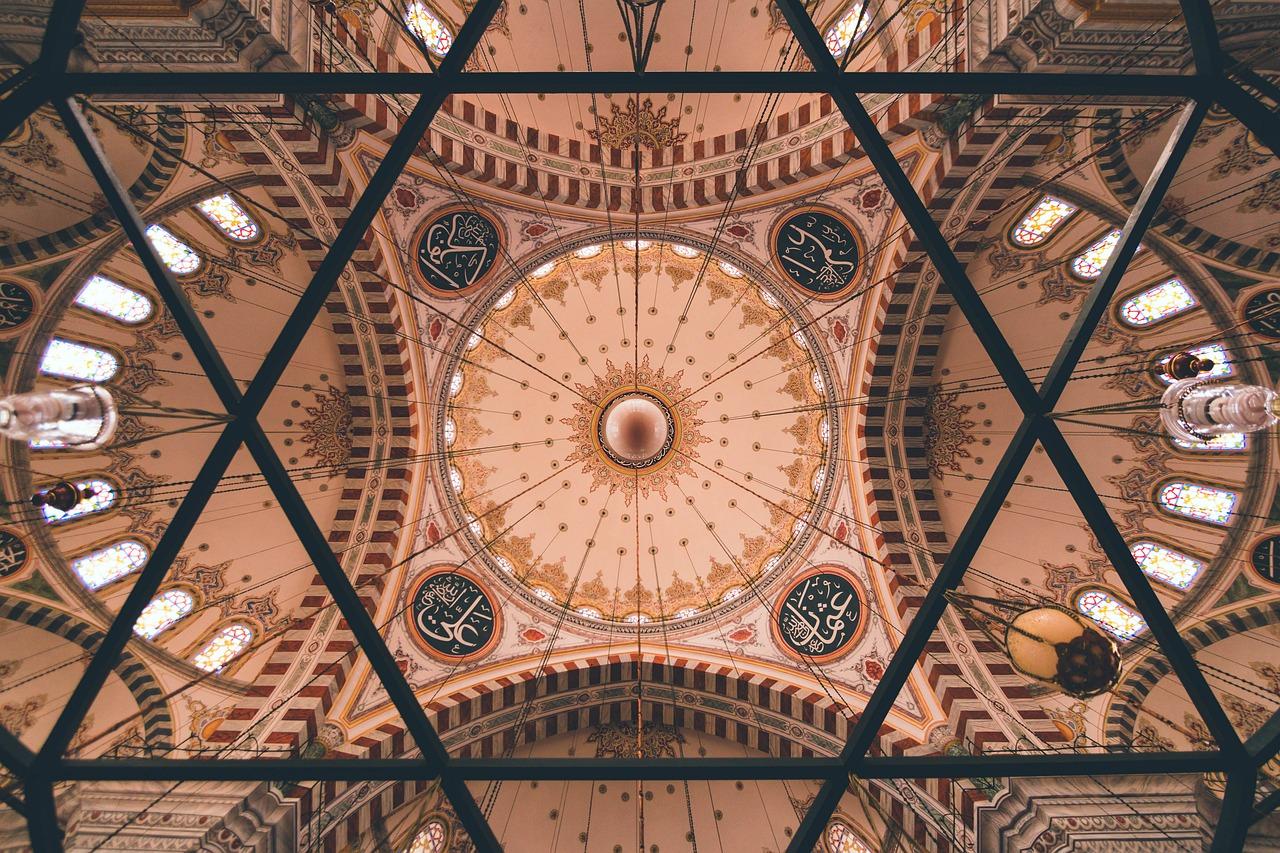
Ottoman period
The Ottoman period was one of the longest in the history of Cyprus, beginning in 1571 when the Ottomans took over the island and lasting until 1878. During this period, Nicosia retained its status as the capital and was the seat of the Sovereign of Cyprus, while other high officials, nobles and gentry also resided in the city. The city remained the main commercial centre of the island and was home to many merchants and traders.
Nicosia was an important supplier of products such as wine, cotton and sesame. The Oriental Ottomans' love of bazaars was not lost on Nicosia, where many markets were opened. It is noteworthy that there was even a special 'women's market' where women could trade. It was opened once a week on Fridays and was a great success.
Undoubtedly, this period left a vivid and distinct mark on the architectural appearance of the city. Government buildings, mosques, hammams, hotels (inns), educational institutions, residences of nobles and aristocrats and ordinary residential buildings were built in the typical oriental style.
Ottoman architecture was characterised by rounded forms: many arches - both internal and external, rounded niches in the walls, spacious rooms, courtyards with gardens and fountains, geometric decorative ornaments. The buildings had thick walls of raw bricks made of a mixture of straw and clay, and their facades were finished with local stone.
Several well-preserved and restored buildings from the Ottoman period have survived to this day.

House of Hadjigeorgakis Kornesios (House of Hadjigeorgakis Kornesios)
Located in the centre of the old town in the Ayios Antonios neighbourhood, this mansion is not only a unique architectural monument but also an ethnographic museum. The majestic two-storey residence, built in 1793, was the home of one of the most famous dragomans (translators) of the time. In the Ottoman-controlled territories, a new position of dragoman was introduced - the official interpreter of the Sultan's Council, a kind of intermediary between the Ottoman ruler and the locals. It was the most prestigious position that Christian subjects of the Ottomans could be honoured with. This title allowed its holder to gain power and wealth. As a result, the residence is characterised by extraordinary luxury and spaciousness.
The main entrance and the outer wall of the villa are particularly monolithic, reminiscent of a fortress. The entrance is crowned by a multi-tiered arch, above which is a marble slab with a bas-relief of a winged Venetian lion. The animal's paw is raised above an open Gospel with the Latin inscription 'Pax tibi Marcel Evangelista meus', which means 'Peace be with you, Mark, my Evangelist'. To the left of the lion is a fortress with a flag, and below its feet in the centre is a coat of arms with a double-headed eagle and a cross on a hill in the middle, with pomegranate branches around it. The crest with the cross on the hill resembles the form of the crest of the Podakadaro family, a very influential Latinised Greek aristocratic family of the early 16th century. The name of this family is immortalised on one of the bastions of the walls of the old city of Nicosia. However, the Hadjigeorgakis family had nothing to do with the Podakadaro family, suggesting that this bas-relief may have been taken from another building and used in the design of the mansion.
The architectural plan of the building resembles the Greek letter 'P', in which there is a spacious courtyard with a garden and a fountain in the centre, as well as a large hammam consisting of three rooms. On the ground floor are the servants' quarters and the kitchen, and on the first floor, where a stone staircase leads to the reception rooms, the formal reception room communicates with the rest of the first floor.
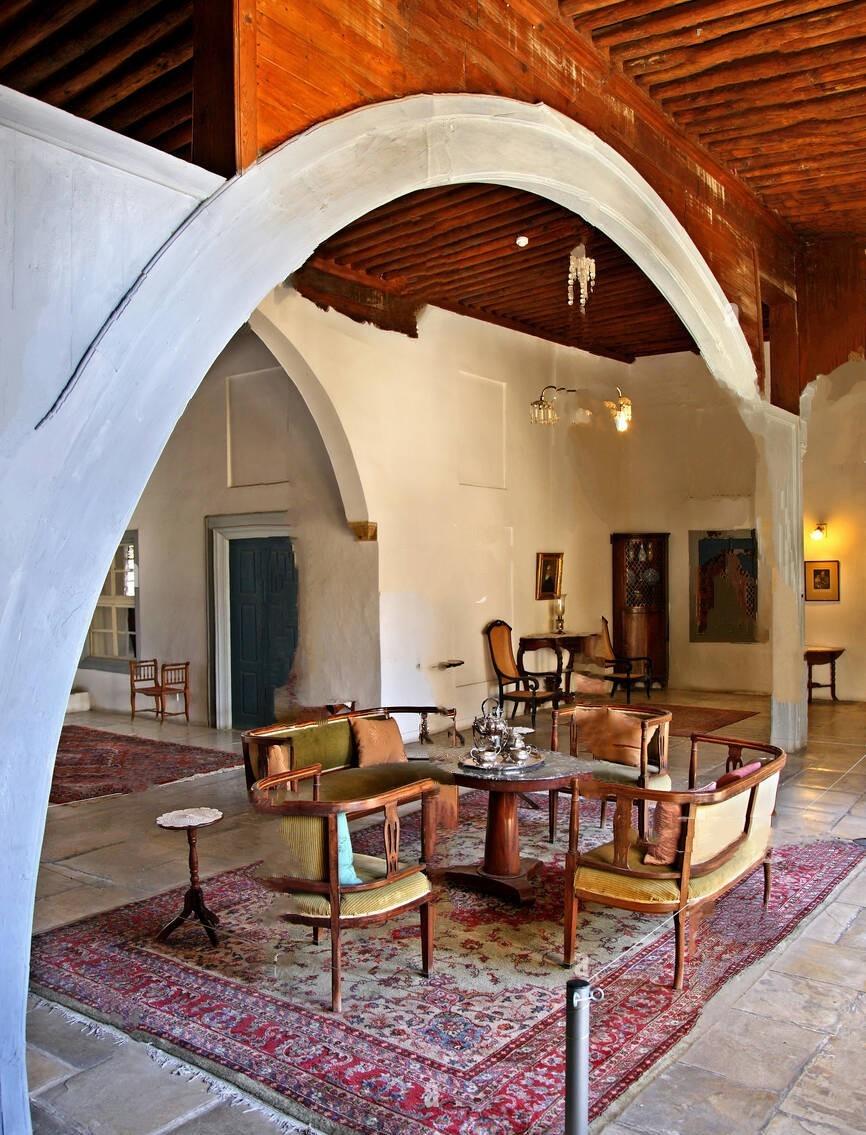
The rounded arches of the entrances and the many windows make the room even brighter and more spacious. Among the other rooms, the most interesting is the large square room with fourteen windows in two rows, called the Honourable Tree because it was once used as a place of prayer. The interiors are also strikingly luxurious and elegant, and although much of the furniture dates from later periods, many family heirlooms, decorative details and Ottoman-era objects have been preserved.
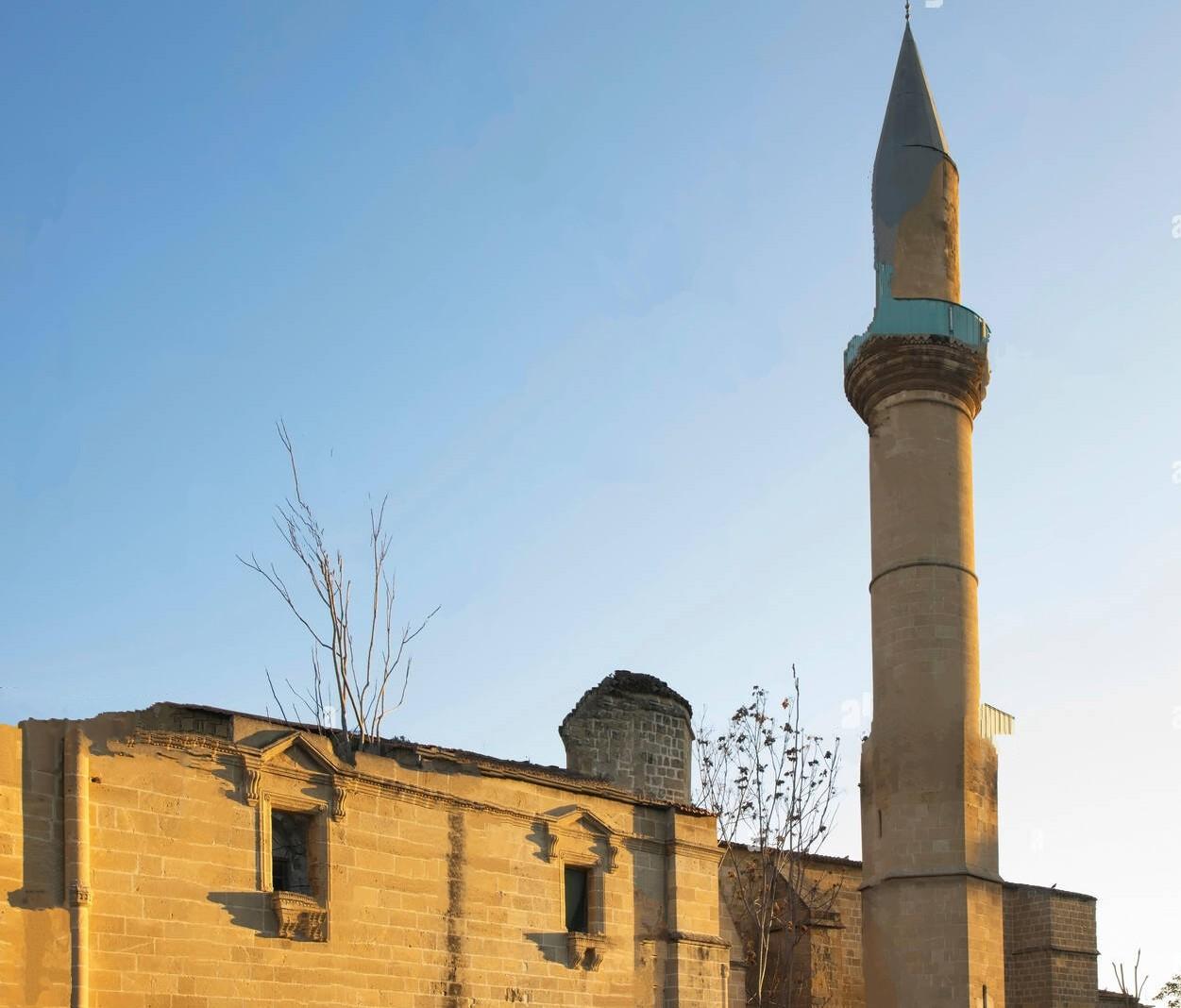
Omerye Mosque and Ottoman Baths
In the heart of the old town is another unique monument of Ottoman architecture. The Omerye Mosque was once a medieval Augustinian monastery built in the 14th century during the Lusignan era and dedicated to St Mary. It was one of the largest monasteries in Nicosia at the time and covered an area of 6 hectares with fields, gardens and even a sugar plantation. After the Ottoman Empire took over the island in 1571, the monastery was converted into a mosque by Lal Mustafa Pasha, who believed that the monastery stood on the site where Caliph Omar was buried. Camille Enlard, a French researcher and historian, described in her book 'The Gothic Revival and Art in Cyprus' in 1899 that most of the Lusignan buildings were destroyed by the Ottomans during the conquest of the island and that the painted Lusignan tombstones found in the former monastery were used in the construction of the mosque floor.
The base of the mosque follows the outline of the former temple, but its architecture is a peculiar mixture of Gothic and Ottoman influences. Most of the mosque is in traditional Islamic style, with characteristic elements such as numerous arches, rounded domes and a tall minaret. However, elements of the Lusignan style can still be found on the exterior. For example, the main entrance belongs to the original 14th-century church building, whose façade retains decorative details and bas-reliefs, while the north-eastern wall has a Renaissance door that also belongs to the original convent building. According to Camille Enlar, this wall was part of a monastic hotel for pilgrims built by the Latin Archbishop of Cyprus. The mosque was part of a larger complex dedicated to the memory of Caliph Omar. The complex included the city's bathing hamam, which was built on the orders of Lala Mustafa Pasha as a gift to the people of the city.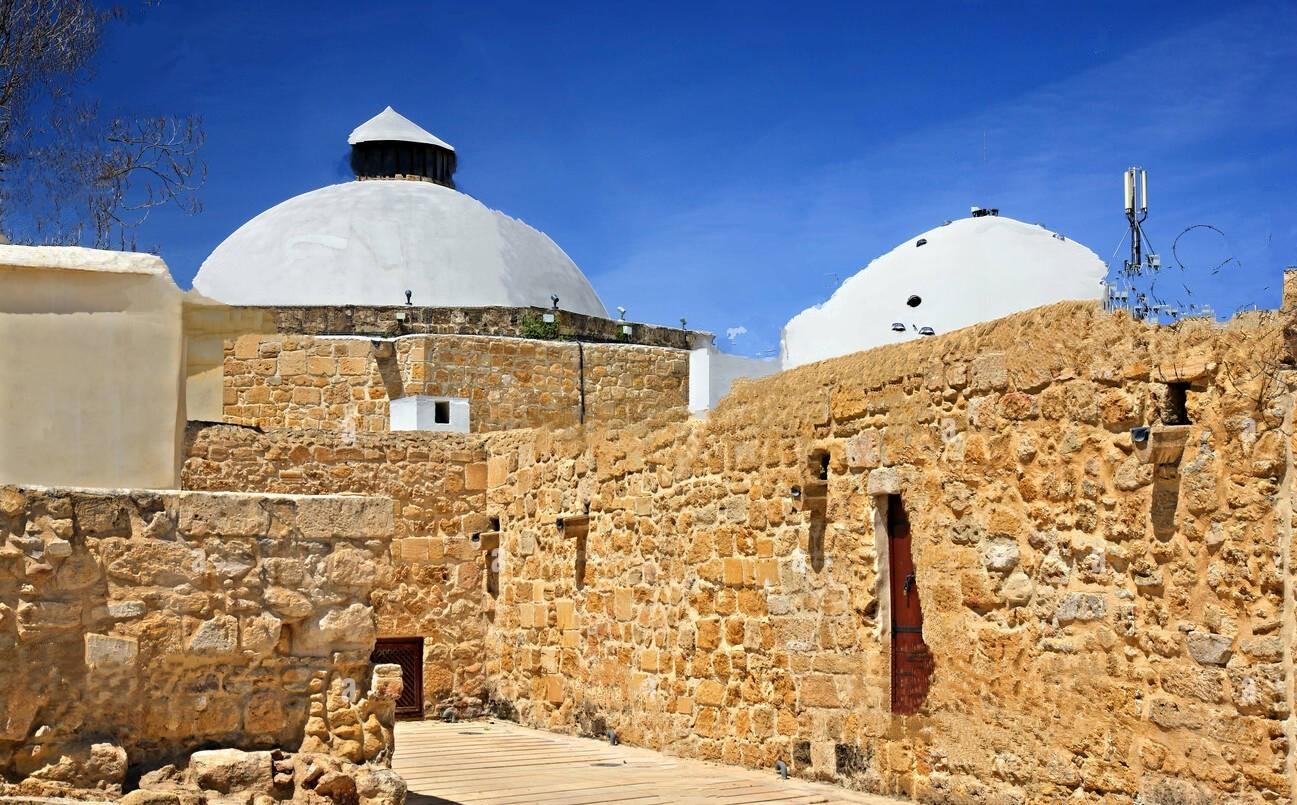
Omeriye Hamam
The hamam is located near the mosque in the centre of the old city. Built in 1571, it is a rounded structure made of limestone from the quarries of Nicosia, known for its rich ochre colour. Beneath the rounded vaults is the hamam, which has been open to the public from the day it was built to the present day, with the exception of a three-year period of restoration in 2002.
The building has two entrances, one to the north and one to the south. The southern entrance is accessed through a small patio. The layout of the rooms is typical of traditional Ottoman hammams of the period.
At the entrance is a large square room - the 'cool' room - with rounded vaults and a dome. There is a small octagonal pool in the centre of the room, and there are sofa beds around the perimeter. These sofas are covered with draped curtains for privacy. The 'cool' room serves as a sort of preparation area where you can change clothes.
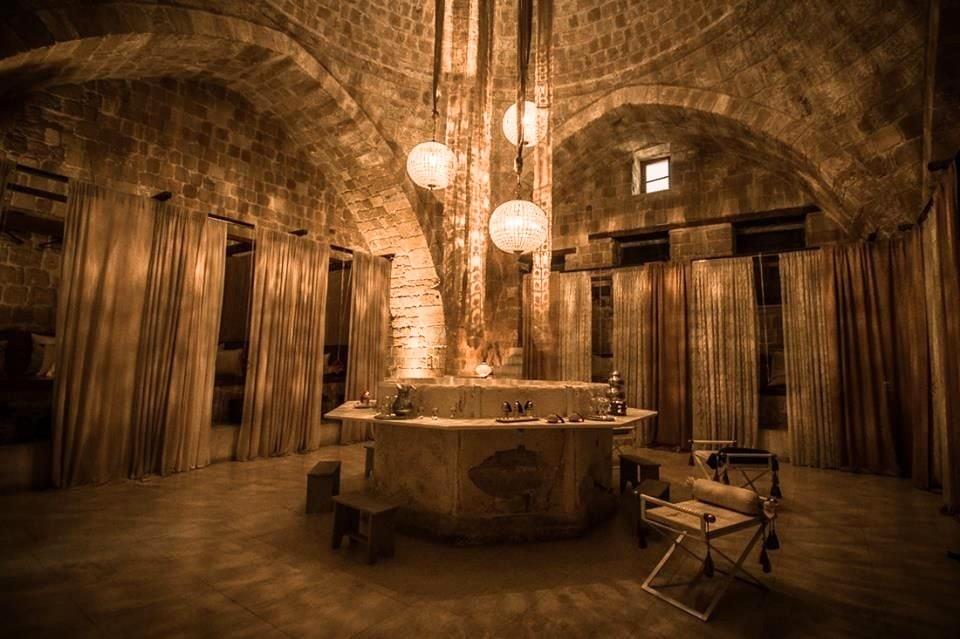
Next is the 'warm' room, which is divided into three main rooms. Each has a vaulted ceiling and pointed arches. Traditionally, these rooms were used for grooming, such as washing and dyeing hair. The moderately hot temperature of this area helped to acclimatise before entering the third hottest part. The climax of the hamam visit was the 'hot' room, where the temperature reached 36-38 degrees Celsius. It was a square room under a central dome, with smaller compartments - 'khalvets' - in the corners. Each khalvet has two marble baths with hot and cold water. The room is illuminated by sunlight entering through star-shaped slits in the domed ceiling. In the centre of the hot room is an 8-cornered stone slab, about 50 cm high, which is used as a massage bed.
After visiting the 'hot' room, it is advisable to visit the rooms in reverse order, so that you can acclimatise smoothly to the lower temperatures: first the 'hot' room, then the 'cool' room, where you can relax and unwind before leaving the hammam.
The restoration of the Omeriye Hammam began in 2002 and has been carried out with the utmost care to restore and preserve the original appearance and unique oriental charm of the building. In 2006, the project won the prestigious Europa Nostra Award. Many visitors now describe the Hamam as the jewel of Ottoman architecture in Nicosia, and the space inside as a time travel experience that allows you to immerse yourself in the atmosphere of the Arabian Nights. The Omerieh mosque and hammam are still active and open to the public.
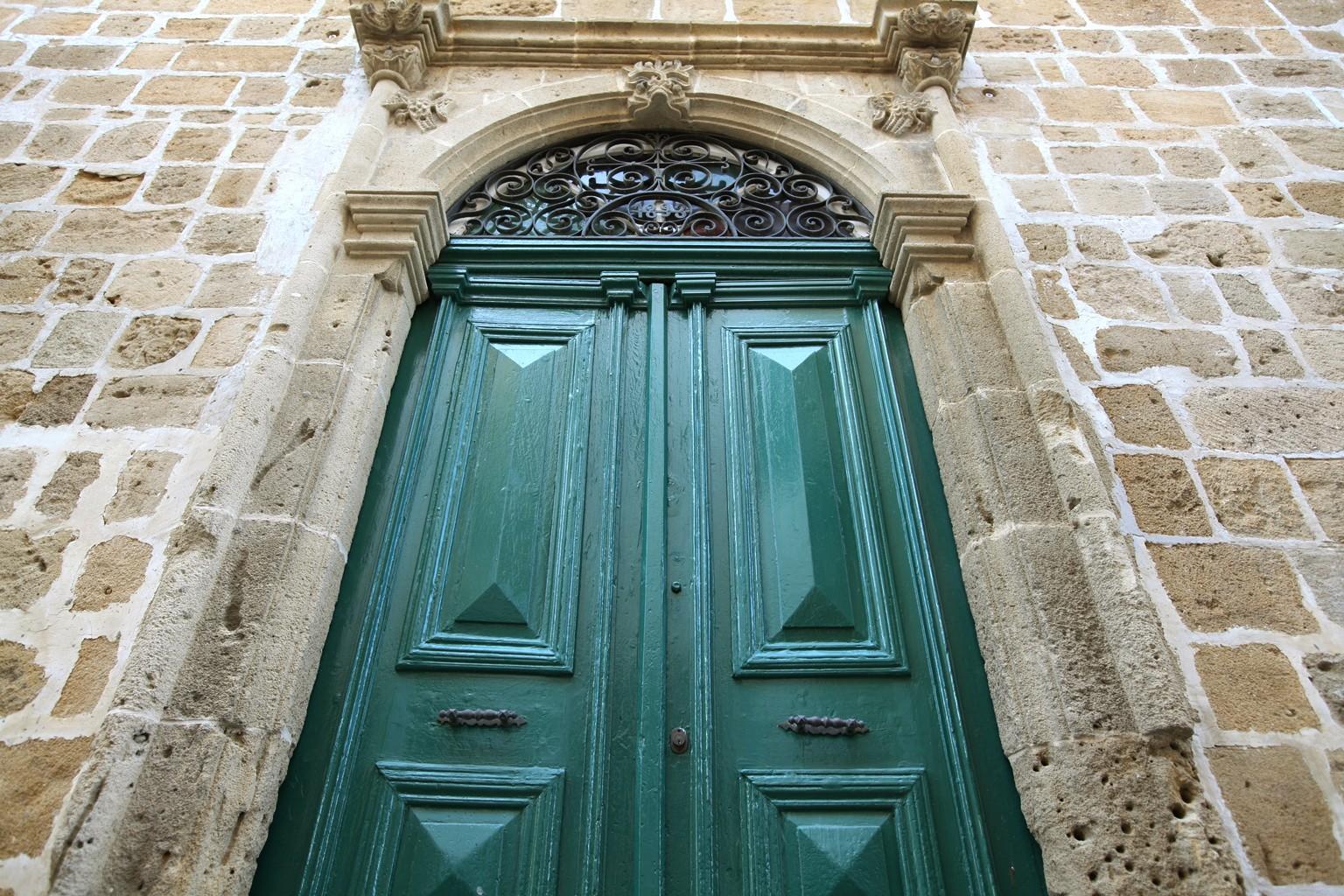
Archontiko Axiothea Mansion (Archontiko Axiothea)
This old 18th century mansion is a characteristic example of later Ottoman urban architecture. Located in the centre of the old town, close to the Green Line, the building resembles the letter 'P' typical of Ottoman architecture and is built of limestone blocks. The building originally covered an even larger area, but part of it was demolished over time.
The main entrance is on the east side and leads to the courtyard. There is a high doorway on the front. The bas-reliefs of the main entrance are truly unique: two slender columns with elegant capitals and corners, joined by a cornice in the middle of which is a decorative element in the form of two intertwined branches and, a little lower down, two birds ready to take off.
There are also two windows with different decorative elements: the first is decorated with a relief with the head of an angel with wings, and the second with the head of a woman wearing a necklace and three rosettes (decorative details). The cornice has a recess for keys.
The inner colonnade is made up of 13 slightly pointed arches, and there is also a loggia with columns. The whole architectural ensemble is reminiscent of a convent. On the ground floor there are three large halls and two smaller rooms, as well as two service rooms, and on the first floor there are three more halls or salons and two rooms. Today, the mansion serves as a venue for cultural events in the capital, such as art exhibitions, performances and literary seminars at the University of Cyprus.

British colonial style
British rule in Cyprus lasted from 1878 to 1960. During this time, many administrative buildings, educational institutions, roads and public spaces were built. Today, around 700 different colonial buildings remain throughout the island. According to Costas Georgiou, author of a book on British colonial architecture in Cyprus, there is no single style of colonial building, each building is unique in its own way and is a mixture of styles and periods.
Native British styles were introduced into the architecture of the buildings - Victorian, known for its abundance of decorative details and elements, and Georgian, characterised by symmetry, elegance and harmony of proportions. At the same time, neoclassical elements, reminiscent of ancient Greek columns, were used to decorate building facades and grand entrances. Many of the buildings also have elements of local Cypriot architecture, as local materials such as limestone and wood were used in their design and construction, often employing local specialists as well as builders from the island of Malta. Some buildings were based on older buildings, either Venetian or Ottoman, and retain elements of these periods.
In general, the British Colonial style in Nicosia can be described as a mixture of the above styles. Colonial buildings are recognisable by their symmetrical structures, with hewn limestone finishes of a dark ochre colour and tall windows with external wooden shutters.

Presidential Palace
The Presidential Palace, formerly known as the Governor's Palace, was the residence of the British Governor of Cyprus. The first Governor's Palace was a wooden building which was burnt down in a fire during the 1931 uprising. It was then decided to build a stone building. The architectural plan of the palace resembles a horseshoe. Its design combines Byzantine, Gothic and Ottoman elements.
The main entrance is on the north side and is in the form of a two-storey building with an arched porch on the ground floor and a smaller covered arched porch on the first floor. The shape of the arches is reminiscent of Gothic lancet arches. The main decorative element of the main entrance is an imposing bas-relief of the British coat of arms. The door of the main entrance was modelled on the door of the Monastery of St John Chrysostom in the Pentadactylos Mountains. Each doorframe was made up of at least 288 small wooden pieces from 6 different types of wood, which were joined together without the use of nails or screws.
There are several other curious details in the architecture of the palace. For example, in the centre of the northern wing there is a tower, a copy of the medieval castle of Kolossi. On the south side you can see the gutters with decorative faux elements: four of them depict people, including the foreman, the head carpenter and unknown workers. The other four gutters are in the shape of Cypriot animals - an ox, a donkey, a camel and a ram. The main material used for the construction was porous limestone from the Gerolakkos area, known for its durability. Many wooden elements were also used, both from local species (pine, sycamore, eucalyptus, walnut, cypress and mulberry) and from other countries in the then British colonies of Burma and Canada. During the 1974 uprising, the palace was completely burnt down, except for the supporting walls, but was rebuilt a few years later and since 1979 has been the office and official residence of the President of the Republic of Cyprus.

English School
In the neighbourhood of Strovolos there is a unique historical building, the English School, which is a striking example of colonial style. Its founder was an Anglican priest and teacher, Frank Darwall Newham. Founded in 1900, the school initially had only 13 pupils, but gradually expanded and in 1939 it was decided to build a new campus in the Strovolos neighbourhood.
The design of the main school building was led by the architect Odysseas Tsangaridis. He created a design that reflects the traditional British style, while incorporating elements of local colour. The building is a two-storey rectangle, with pointed arches along the main central wing and the east wing. Instead of arches, the west and north elevations have windows with wooden shutters. The wings of the complex are rather narrow, which allows natural light to enter and improves ventilation. There are 18 classrooms on both floors.
The building is constructed in load-bearing masonry and finished with dressed limestone on the outside, with a red tiled roof. The windows are vertically proportioned, which gives a certain rhythm to the whole project. The main entrance rises above the steps that lead to the porch through an ogival arch supported by stone columns, the tops of which are decorated with floral motifs. The covered arcades on the south side are surprising in their delicacy. On the ground floor, they are made up of rounded Cypriot-style arches supported by low columns. On the upper floor, the pointed arches are supported by pillars instead of columns. The corridor behind the arches is protected by a thin iron balustrade with a cross ornament, separated by vertical inserts. The English School is still in operation today and is renowned for its elitism, rigorous selection of pupils and high standards of education.
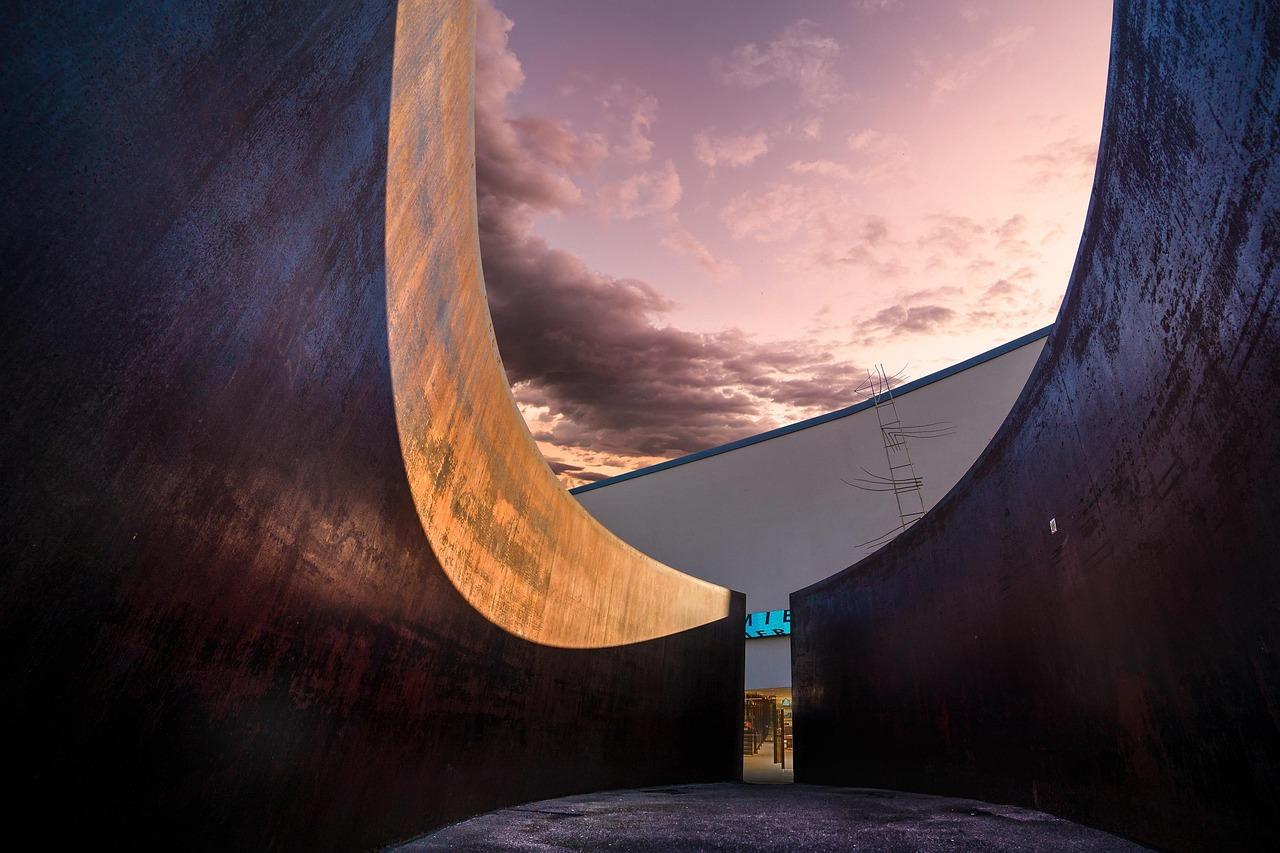
Modern buildings
As Nicosia continued to develop, the industrial age brought a new turn in the development of architecture. The 20th century gave the capital many interesting buildings, some of which are true masterpieces of avant-garde and modernism. Today, world-renowned modern architects create their bold and unique projects here, transforming the city and making it even better.
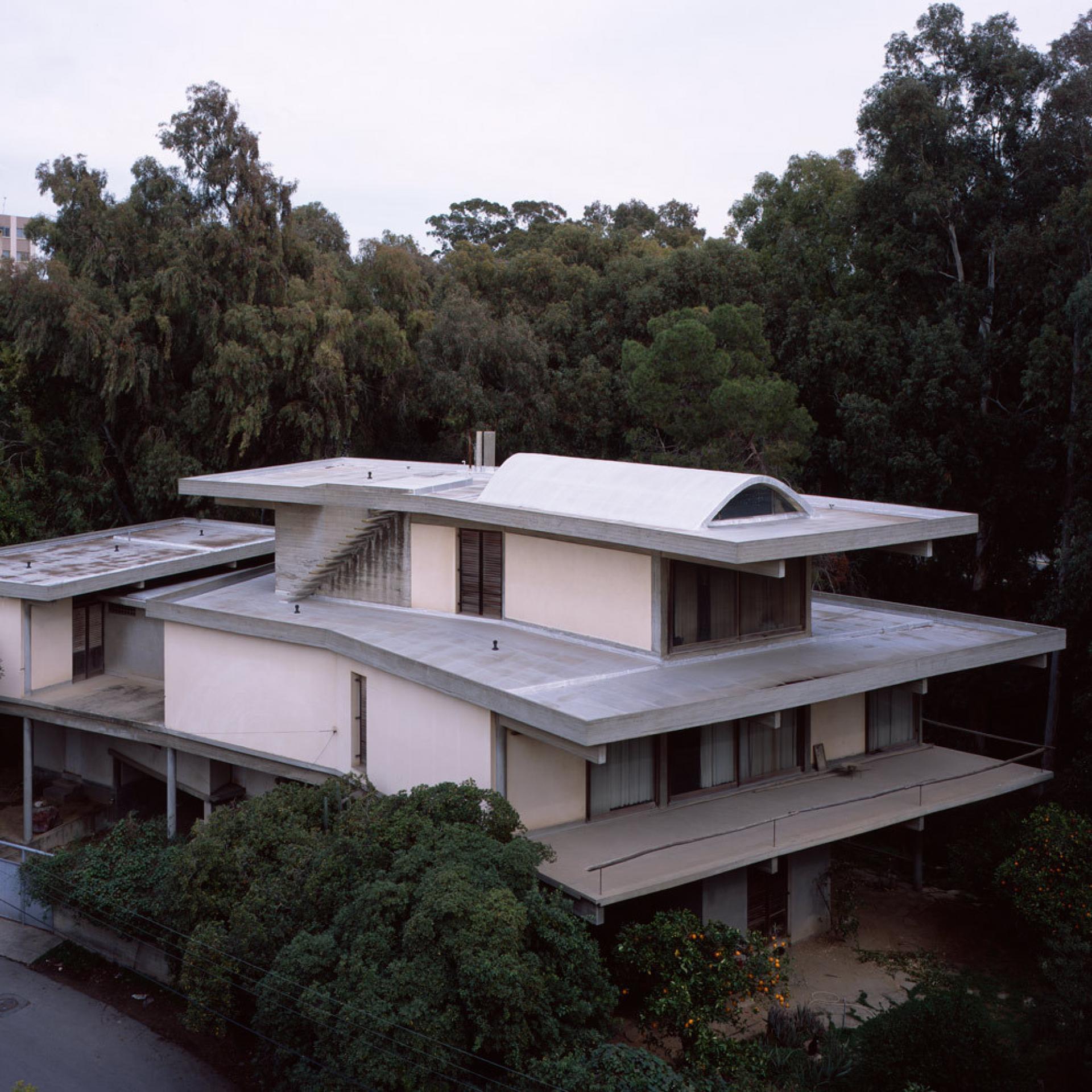
Neoptolemus and Maria Michaelides House
Neoptolemus Michaelides was one of the most prominent Cypriot architects of the last century. He was also widely known as 'the father of 20th century Cypriot architecture'. After graduating from the Milan Polytechnic in the 1940s, he was inspired by the spirit of the Italian avant-garde of the time. He was the author of many architectural projects, but one of his best designs is his own house, which he designed as a residence and working studio for himself and his wife Maria, who was an artist.
Built in 1966 on the picturesque banks of the Pedieos River in the centre of Nicosia, the house blends into the surrounding landscape, echoing the horizontal lines of the river. Hidden from the pedestrian path behind the crowns of tall trees, the house continues to inspire and impress with its laconic forms and harmony of lines. The ground floor, which houses the public areas, living room and guest bedrooms, contrasts with the quieter and more private first floor, where the master bedrooms are located, and the third floor consists of a secluded studio space covered by a parabolic vault. The studio windows offer picturesque views of the river.
During construction, great care was taken to use local natural materials and to preserve their natural colours and textures. Although minimal materials such as concrete, marble, steel and wood were used, this helped to create such a dramatic effect and allowed the focus to be on the beauty of the interior and exterior forms. Each material plays its own important role in creating the overall impression. The walls and ceilings are unpainted and made of pale concrete. All floors are connected by marble steps framed by a concrete slab. The banisters and other raw wooden details will become more interesting over time.
The courtyards and terraces are an extension of the interior and are positioned to take advantage of the local climate: the movement of the sun and the midday breeze. Sunlight enters through a well-designed system of holes and openings in the walls and ceiling, bringing out the natural colours and textures of the concrete, creating a cosy yet mysterious space. In many ways, this project was ahead of its time - aspects such as sustainability and the relationship of design to the surrounding landscape would only become widespread a few decades later.
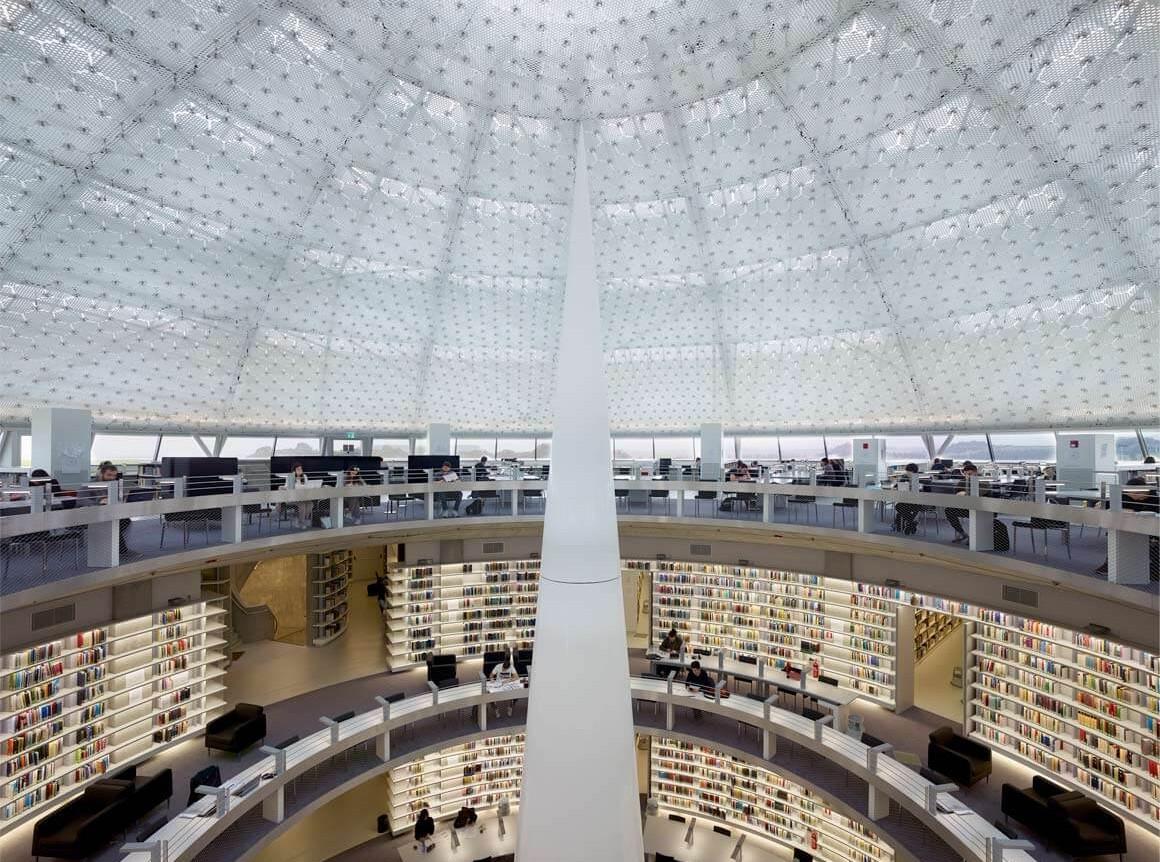
University of Cyprus Library, Stelios Ioannou Centre
The library is named in honour of Stelios Ioannou, who donated around €8 million to the project. It was designed by the internationally renowned architect Jean Nouvel, who had completed another of his projects in the centre of Nicosia a few years earlier. The library is a truly ambitious architectural project, combining technical innovation, sustainability and aesthetics.
Five floors cover an area of 15.7 thousand m2. Two floors are underground and three are hidden inside an artificial hill covered by a dome made of a transparent membrane that allows sunlight to penetrate. The membrane has UV protection. From the outside, the dome resembles an abstract installation in blue and green.
In the centre, inside the dome, is the geostat - a white cone, 5 m thick and 24 m long, the surface of which is covered with special panels. These collect the sunlight and distribute it to all the floors, even the underground rooms. The entire space inside the dome appears to expand in a spiral, with the upper floors having a larger radius than the lower floors. The top floor offers a 360-degree view of the surrounding landscape. The library holds around 600,000 print publications, 40,000 digital publications and a further 10,000 audio-visual materials and is a popular place for students.
Read also:


